How Bends Are Notated in Guitar Tablature
Tablature specifies two aspects of a bend: the size of the bend and the type of bend. The rhythm of a bend should always be determined by looking at the standard notation.
Size of the Bend
The size of a bend is specified by a number or word above the note. A string can be bent up a 1/4 step, 1/2 step, whole step, or more. Whole step bends may be notated with a '1' or the word 'full'. Other sizes are notated with fractions or whole numbers.
1/4 Step Bends
Bend the string up a 1/4 tone. The pitch of the note is half way between the note on one fret and the next.
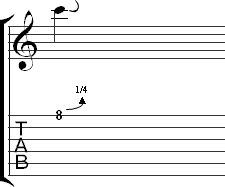
A 1/4 step bend doesn't have to be exactly a 1/4 in most cases. These bends are generally used in blues licks where the goal is to have a slightly out of tune note.
1/2 Step Bends
Bend the string up a half step. This is the distance from one fret to the next. For example, the fourth fret to the fifth fret.
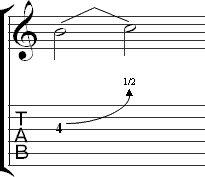
Whole Step Bends
Bend the string up a whole step. This is the distance from one fret to two frets up. For example, from the eighth fret to the tenth fret. The bend may be indicated by a '1' or the word 'full.'
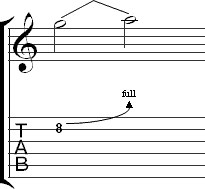
Bends of other sizes, including 3/4, 1 1/2, and 2 step bends, are possible, but those listed above are most common.
Type of Bend
The type of bend is indicated by a line above a note. The line may be straight, or curve upwards or downwards. All of the bends shown previously are the simplest kind of bend, where a note at the specified fret is bent up to a higher note.
Prebends
Prebends have a straight line and an arrow above the number. This indicates to bend the string to the specified pitch before playing it.
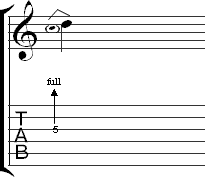
Bend and Release
A release is indicated by a line pointing upward and another curved line with a downward arrow at the end. The downward arrow indicates to release the bend. The bend may be released all the way or to a specified amount above the fretted note. The release will generally go back to the fretted pitch, but it can also be released to a pitch above the note you are fretting. For example, a 1 1/2 step bend could be released by a whole step so that the bend is still a 1/2 step above the fretted pitch.
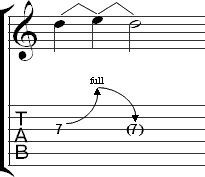
Prebend and Release
A prebend is indicated with a straight line extending from the note and a curved line with an arrow that points down. This is played by bending the note to the indicated pitch before playing it, playing the note, then releasing it.
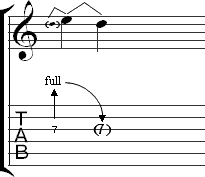
Bends Involving More Than One String
Bends involving more than one string are possible. All the notes can be bent or some can be bent while the others are stationary.
Unison Bends
A unison bend is a bend that involves two notes, where one note is bent up to the pitch of the other note. In the example below, the seventh fret on the third string is bent up to the pitch of the fifth fret on the second string.
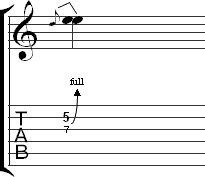
Multi-string Bends
Bends where two or more notes are bent will have a line from each note indicating how much each note should be bent.
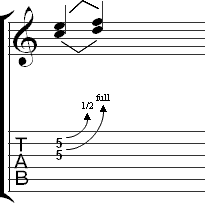
Stationary Bend
Stationary bends are bends where one note is bent while other notes are held. This is a common technique in country and blues music. Publishers may use several different ways of notating these bends depending on the situation. It is usually obvious from the notation what is intended.
Grace Note Bends vs. Rhythmic Bends
Tablature won't give you the rhythm for the bend, so you should use the standard notation for determining the rhythm of the bend. When bending from one note to another there are two categories of bends:
Grace Note Bends
Grace note bends are bends where the string is bent to the indicated pitch immediately after it is picked.
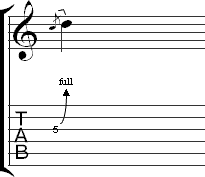
Rhythmic Bends
Rhythmic bends are bends where the initial note has a rhythmic value and the bend occurs once its value is over. These bends can include any combination of rhythms. The example below includes two half notes. Play the first note and hold it for the duration of the half note. Bend the string to the second pitch to coincide with the second half note.
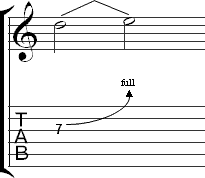
Even if you don't read music fluently, you can determine which type of bend is used by looking at the notation. A grace note bend will appear as a smaller note next to a full-sized note in notation whereas bends that are rhythmic will have notes of the same size.
